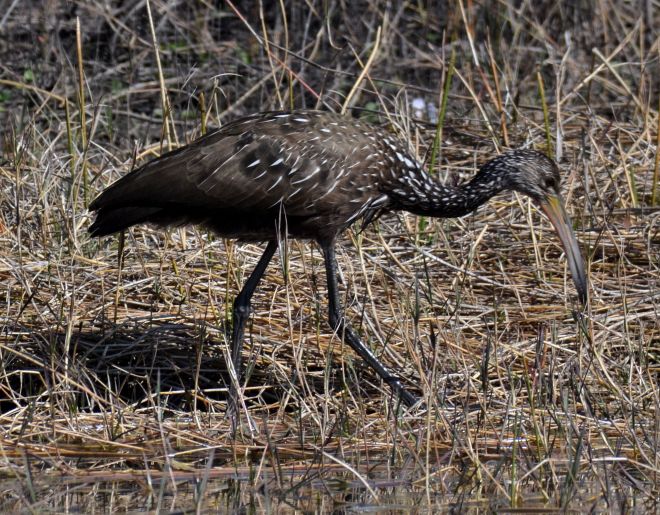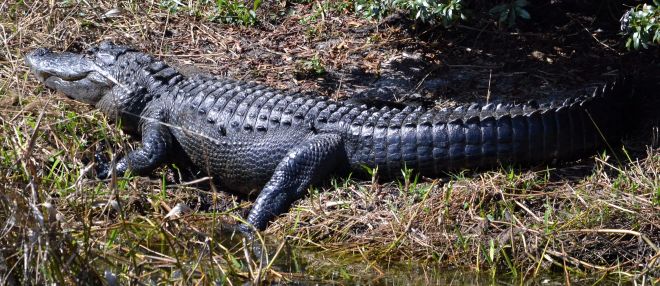Herewith a round-up of some other locations visited and wildlife observed during my 19 days in Florida. I commented in part 4 on the lack of walkable countryside in the sunshine state. That perception changed on the last two days of this trip when I was pleased to at last find two big expanses of unspoilt original habitat with general access and mercifully no visitor facilities. So such places were out here after all.
Upon researching somewhere to go to fill my final day (25th) I became aware of the Babcock / Webb Wildlife Management Area some 15 miles to the north of Fort Myers. It sounded like a possible area in which to locate further birds I wanted to see in Florida, such as some more Woodpeckers, Blue and Scrub Jays, but most of all the enigmatic Limpkin. At the preserve entrance, just off the US-75 highway is a chain of water bodies known as Webb Lake and that was where I commenced my search.

The enigmatic and mysterious Limpkin, a Florida speciality
The WMA’s only metalled road snaked between this feature and the nearby highway away to the west. It was clear most of the other interested parties here were anglers, but I had chosen well since at each likely looking stopping place I did indeed observe Limpkin. There was one by itself at my first stop, a group of four at the next, and three more on the return drive that were close enough to digiscope adequately. Two Sandhill Crane as a fly past provided a second welcome life list addition here.
Limpkin inhabits freshwater habitats including lake margins, swamps and water courses, where the diet is frogs, snails and insects. Its range within North America lies almost entirely within Florida. Sibley describes the species as an unusual bird, combining characteristics of a large Rail or small Crane. Well it would certainly be a very elongated Rail, with down-curved yellow bill and dark olive legs. The plumage colouration is generally brown with white flecking on the body and a buff toned head. These birds conveyed a certain out of the ordinary, even primeval quality and charm as they moved sedately through the marginal vegetation with a limping gait, hence their name.
Having seen my top target so well I then drove further into the WMA, finding it to be another of those places I so often get into abroad in which it seems possible to walk or even drive for hours in a single expansive habitat, most probably without noticing a lot. Of the few birds encountered, the only ones that didn’t fly up and into the sun ahead of my approaching vehicle were a group of Common Ground Dove.
It struck me the best way to explore what seemed like interesting habitat would be by mountain bike. I am always wary of taking a hire car on dirt roads, so not wanting to tempt mishap and having forgotten to bring any food I decided not to persevere and so returned to base for a lunch break. That was not before encountering the trip’s final American Alligator (below), that like myself was contentedly on its own at the back of beyond.

Babcock / Webb WMA Alligator, the last one of the trip
In the afternoon I paid a second visit in as many days to the Estero Bay State Buffer Preserve in Fort Myers. As if to confirm my earlier sentiments I came upon next to no birds, just a handsome Gopher Tortoise (below, left) but it still felt good to be walking in such a large expanse of natural habitat and to think it is being preserved as such smack in the middle of what is a highly developed district.
On my first visit the previous afternoon I had expected another public park but actually found a huge tract of original habitat that has been set aside as a buffer against development and to help preserve ecosystems. How refreshing, and now I knew what this part of suburban Florida must have looked like before all the condominiums, country clubs and golf courses were fashioned out of the landscape. I came across a Downy Woodpecker, the US’ smallest of the family, while a Loggerhead Shrike (above, right) hunting on territory was busy behaving as grey Shrikes do everywhere.
The wildlife interest that time was otherwise mainly butterflies, mostly the same as I had been finding all trip but three new ones as well. Pearl Crescent (above, left) is a common and widespread species throughout much of the US and Mexico, being found in a variety of non-specialised habitats. Cassius Blue (above, top right) is resident throughout the year in southern Florida, producing at least three broods. There are many and similar Skipper species in North America so I will not attempt to ID the one seen here (bottom, right).
On my first and last days in Homestead (8th and 18th) I visited Biscayne National Park on the coast to the east. Since 95% of it’s 172,971 acres is water, between the Mangrove swamp coastline and the offshore Florida reef system, much of the wildlife interest here is marine. But the park’s only land based area around its Dante Fascell Visitor Centre offers seabird watching over the bay. It was here after driving south from Miami on day 1 that I first encountered Brown Pelican, Royal Tern, Bonaparte’s Gull, Green Heron and the subsequently ubiquitous Yellow-rumped Warbler.
A private boat hire concession operates from here, allowing visitors to explore the mostly impenetrable Mangroves to the north and south where American Crocodile and Manatee can be found. But I have no experience of canoeing or kayaking and in any case was alone, so that otherwise attractive option was not possible.
Immediately south of the centre lies Homestead Bayfront Park, which is more a boating facility than a nature reserve. But the marina piers held an interesting accumulation of approachable seabirds (above and below) that on 18th were much easier to photograph than they had been in The Keys. Some of the pictures in part 1 were indeed taken here.
But perhaps the stand-out bird that morning was a rather impressive white-morph Great Blue Heron (below). Also known as Great White Heron, this largest of all American herons is found only in Florida where it is most prevalent in The Keys. Adult white and indeed blue-morphs here can be 10% larger than the norm for Great Blue (per Sibley), and exhibit a very heavy bill. Just look at that magnificent weapon!
My thanks are due to Oxon county recorder and north American bird authority Ian Lewington (see here), for kindly checking through these five Florida posts and putting me right on some of the trickier IDs, including this one.
Lastly, I didn’t include the following sequences in part 3 so as not to overload that post with Alligator pictures. These were all from the Oasis visitor centre on the Tamiami Trail that held the largest concentration of the reptiles I came across during this trip. It seems fitting the series should end with a further celebration of these magnificent creatures that together with all the Herons were my prime reasons for wanting to take a winter break in Florida this year.
I can only proclaim once more, as often before in this journal that I love all reptiles. And these big and beautiful beasties most certainly didn’t disappoint. This trip was the realisation of a long held ambition. Whether I will re-visit Florida in the future remains to be decided, but hey I’ve done it and the memories cannot be erased.


























